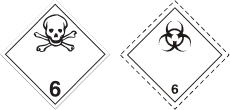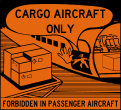There are 9 main classes of dangerous goods. Dangerous goods can present 1 or more of the hazards represented by Class 1 to 9 with some classes split into divisions.
You can find safety data sheets (SDS) available from the manufacturer for specific chemicals and dangerous goods. They are a useful tool for people to ensure that they are sending the goods under the correct classification. Contact the manufacturer if you don’t have an SDS for a dangerous good.
Companies manufacturing their own products will often require a chemist or other specialist to determine that the product is correctly classified.
Hazard labels for dangerous goods
Under regulations, labels must be clearly visible on the outside of the package and must stay on the package while in transit.
You can often find labels printed on most inner packages such as:
- aerosol cans
- bottles of bleach
- containers of thinners
- tins of paint
- many other products which are available at supermarkets and hardware stores.
Below are the 9 hazard labels for the 9 classes of dangerous goods.
Class 1 Explosives

This includes items such as:
- explosive substances
- pyrotechnic devices
- ammunition
- fireworks
- detonators.
Class 2 Gases

These can be transported as:
- compressed
- liquefied
- refrigerated liquefied
- gas in solution.
This includes aerosols. Class 2 has 3 divisions:
- Division 2.1 - flammable gases such as:
- butane
- propane
- Division 2.2 - non-flammable, non-toxic gases such as:
- oxygen
- liquid nitrogen
- compressed air
- Division 2.3 - toxic gases such as:
- chlorine
- hydrogen sulphide.
Class 3 Flammable liquids

This includes liquids with a boiling point of 35⁰ C or less, or a flash point of 60⁰ C or less such as:
- petrol
- alcohol
- perfumes
- essential oils
- hand sanitiser
- paints.
Class 4 Flammable solids

These are substances that can spontaneously combust and substances, that when they come into contact with water or emit flammable gases. Class 4 has 3 divisions:
- Division 4.1 - flammable solids such as:
- hexamine solid fuel tablets for camping stoves
- self-reactive substances
- desensitised explosives
- Division 4.2 - substances that can spontaneously combust under normal air transport conditions include:
- camphor
- sulphur
- matches
- Division 4.3 - substances that emit flammable gases when they come into contact with water include:
- sodium
- zinc particles
- activated carbon.
Class 5 Oxidising substances and organic peroxides

These substances are not necessarily combustible on their own but can react dangerously with other substances. Class 5 has 2 divisions:
- Division 5.1 - oxidising substances that may not be necessarily combustible, but they may readily yield oxygen and cause other materials to combust, such as:
- hydrogen peroxide
- ammonium nitrate
- potassium chlorate
- sodium nitrate
- Division 5.2 - organic peroxides are thermally unstable and can emit heat and give off harmful or flammable vapours. They can also be liable to explosive decomposition and react dangerously with other substances. Examples are:
- acetyl acetone peroxide
- benzoyl peroxide
- peracetic acid.
Class 6 Toxic and infectious substances

These substances can cause sickness, injury or death if consumed. Class 6 has 2 divisions:
- Division 6.1 - toxic substances that can cause death, injury or to harm human health if swallowed, inhaled or by skin contact, such as:
- chloroform
- arsenics
- cyanides
- cytotoxic waste
- barium compounds
- pesticides
- Division 6.2 - infectious substances that contain or are expected to contain pathogens that can cause disease in humans or animals, including:
- medical or clinical waste
- patient specimens
- genetically modified organisms
- infectious substances
- infected animals.
Class 7 Radioactive materials

These are substances that emit invisible ionising radiation that can be harmful to humans and animals. It can cause objects such as aircraft and equipment to become contaminated if not packaged and handled correctly, such as:
- uranium
- radioactive ores
- isotypes
- radium
- cesium
- x-ray equipment
- medical equipment or parts.
Class 8 Corrosives

These substances can cause irreversible damage if they come into contact with skin and could destroy other freight, or materially damage containers or aircraft. This includes:
- acids
- corrosive cleaners
- battery fluid
- formaldehyde
- hydrofluoric acid.
Class 9 Miscellaneous

These are substances and articles which, during air transport, present a danger not covered by other classes. There are 2 types of handling labels – 1 for lithium battery shipments, and another for all other miscellaneous dangerous goods. This class includes:
- lithium batteries
- battery powered vehicles
- battery powered equipment
- first aid kits
- environmentally hazardous substances
- dry ice
- magnetised materials
- asbestos.
Handling labels
In addition to hazard labels, trained staff must attach handling labels where needed. Staff must use these 4 handling labels with the appropriate hazard labels:
Cargo aircraft only

This label is used to show that the load cannot be carried on a passenger aircraft.
Cryogenics

This label is used on liquefied gases, such as the ones in Class 2.
This way up

This label ensures a load is placed the correct way up and can be used for non-dangerous goods.
Magnetised material

This label ensures that the load is kept away from the aircraft compass detector unit while being loaded and unloaded.
Related content
-
Aircraft
-
Aircraft registration
- Change, transfer or cancel aircraft registration
- Data files for registered aircraft
- Ferry flight registrations
- Find a registered aircraft
- Guidance for deceased estates
- Irrevocable deregistration and export request authorisation (IDERA)
- Register your aircraft
- Registered aircraft operators
- Registration marks
- Request a copy of your registration certificate
- Airworthiness
- Certification
- Design and manufacturing
- Sport aviation
-
Aircraft registration
- Drones
-
Licences and certificates
- Pilots
- Radio operators
- Air traffic controllers
-
Air operators
- Aerial application air operator's certificate
- Aerial work certificate (Part 138)
- Air transport air operator's certificate
- Alternative pathways for specialised endorsements
- Balloon air operator's certificate
- Flight training operators
- Foreign operators
- Guidance for Part 91 approvals
- Replace air operator's certificate
- Aerial photography from aircraft
- Delegates
-
Maintenance engineers
- About aircraft maintenance engineers
- Aircraft maintenance engineer exams
- Aircraft maintenance engineer licence (Part 66)
- Apply for a Part 66 licence
- Become a licensed aircraft maintenance engineer
- Maintenance of composite structures
- Part 66 and working for a Part 145 organisation
- Part 66 self-study training and examination pathway
- Recognition of prior learning
- Removing exclusions
- Licence currency and requalification
- Modular licensing for aircraft maintenance engineers
- Part 66 modular aircraft maintenance engineer licence pathways
- Flight examiners
- Flight instructors
- Aviation medicals
- Medical professionals
- Aviation reference numbers
- English language standards
-
Operations, safety & travel
- Aerodromes
- Airspace
- Aviation safety for pilots
- Safety Management Systems
-
Safety advice
- Cabin safety
- Carriage or discharge of firearms on aircraft
- Community service flights
- Cost sharing flights
- Dangerous goods and air freight
- Displays and events
- Drug and alcohol management
- Electronic flight bag
- Fatigue management
- Hazard identification and management
- Human factors and safety behaviours
- Mercy fights and operating in an emergency
- 5G and aviation safety
- Safety incident reporting
- Consumer and passenger advice
- Aeronautical information management
- Rotorcraft performance standards for flight operators
- Training and checking systems
-
Rules
- Regulatory framework
- Rules by category
- Rules by status
- Rules by type
- Changing the rules
-
Compliance and enforcement
- Delegated authority in support of aviation safety investigations
- Enforcement action
- How to comply with the rules
- Recent enforcement actions
- Safety information policy statement
- Sharing safety information
- Strict liability
- Surveillance
- Voluntary suspensions
- Recent enforcement actions
- Reporting unsafe behaviour
- Resources & education
-
About us
- Who we are
- Who we work with
- News, media releases and speeches
-
Reporting and accountability
- Environmental management and performance
- Freedom of information
- Gift and benefits register
- Gender pay gap employer statement
- List of CASA files
- Portfolio budget statements
- Register of privacy impact assessments
- Regulator Performance Framework
- Senate order on agency contracts
- Service standards
- Statement of commitment to child safety
- Work health and safety policy statement
- Protecting the environment
- External security vulnerability disclosure program
- Careers
- Sponsorship and scholarship
- About this website
- Contact us
- Events
- Subscribe

